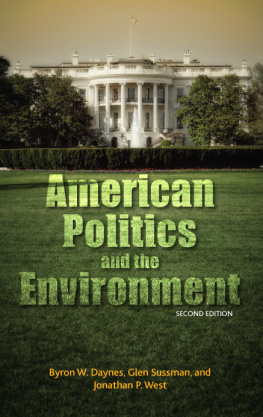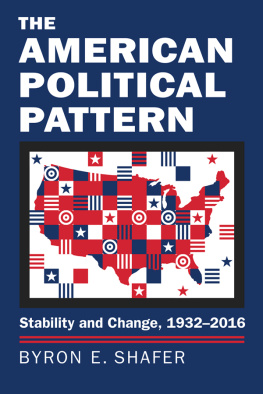American
Politics
and the
Environment
American
Politics
and the
Environment
SECOND EDITION
Byron W. Daynes, Glen Sussman,
and Jonathan P. West
First edition published 2002.
Published by State University of New York Press, Albany
2016 State University of New York
All rights reserved
Printed in the United States of America
No part of this book may be used or reproduced in any manner whatsoever without written permission. No part of this book may be stored in a retrieval system or transmitted in any form or by any means including electronic, electrostatic, magnetic tape, mechanical, photocopying, recording, or otherwise without the prior permission in writing of the publisher.
For information, contact State University of New York Press, Albany, NY
www.sunypress.edu
Production, Ryan Morris
Marketing, Michael Campochiaro
Library of Congress Cataloging-in-Publication Data
Daynes, Byron W.
American politics and the environment / Byron W. Daynes, Glen Sussman, and Jonathan P. West. Second edition.
pages cm
Includes bibliographical references and index.
ISBN 978-1-4384-5933-2 (hardcover : alk. paper)
ISBN 978-1-4384-5934-9 (e-book)
1. Environmental policyUnited States. I. Sussman, Glen. II. West, Jonathan P. (Jonathan Page), 1941 III. Title.
GE180.S87 2016
| 363.70560973dc23 | 2015008205 |
10 9 8 7 6 5 4 3 2 1
To Byron Bill Daynes, a beloved friend,
valued colleague, and respected scholar
Contents
Chapter 1
The American Political Setting and the Environment
Chapter 2
American Federalism and Environmental Politics
Chapter 3
Public Opinion, Interest Groups, and the Environment
.
Chapter 4
Congress, the Legislative Process, and the Environment
Chapter 5
The Environmental Presidency
Chapter 6
Executive Agencies and the Environment
Chapter 7
The Environmental Court
Chapter 8
The Global Environment
Chapter 9
American Politics and the Environment: Conclusion
Figures and Tables
Figure
Tables
The American Political Setting and the Environment
E nvironmentalism is one among many complex and technical policy issues that has challenged political leaders and citizens alike since the dawn of the Industrial Revolution. As one journalist specializing on U.S. environmental policy observed, The economic prosperity of the Industrial Revolutionindeed the rise of Americacame at a steep price: lost wilderness, contaminated waters, dirty skies, endangered animals and plants. By the mid-1960s, the modern American environmental movement focused not only on domestic concerns but also included transnational environmental policy issues ranging from acid rain to stratospheric ozone depletion to global warming and climate change. In short, it became increasingly clear that the United States and other countries were exponentially threatening the health of the environment at home and abroad.
To what extent have U.S. public officials included environmental issues as a central feature of the public agenda? For some, the question of environmental protection concerns value conflicts between preservation and development, where tradeoffs are demanded of contending forces. While some public officials have advocated that the federal government play a strong role in protecting the environment, a limited number of their colleagues are reluctant to impose governmental authority over business and industry with respect to the environment. Still others argue that state and local governments rather than the federal government should play the primary role in managing environmental affairs.
The history of the environmental policy process in the United States has been associated with state-level politics where policymakers, more often than not, have supported economic development over environmental protection.
The political struggle regarding the environment is framed within the American constitutional system of government involving the three major institutions of the federal government. A secondary consideration involves federalism and the extent to which the national government and the fifty state governments should play a role in environmental management. The environment as an important public policy issue also includes the debate over the extent to which science should be involved in environmental policymaking. Consequently, environmental management can be viewed as being subject to a variety of influences that have affected the decision-making process.
The American Political System, Public Policymaking, and the Environment
In the American political system, public policy is subject to a variety of political constraints including but not limited to the dispersion of power prescribed by the Madisonian model of separation of power and the system of checks and balances. The federal system of government divides political power between the national government and the fifty states. Moreover, as the framers of the Constitution were well aware when they argued in Federalist #10 , the governmental system was subject to pressures exerted by organized interests. This motivated the framers to design a system that would moderate the actions of the myriad political actors within the system.
In the American political setting, the three major national institutions (legislative, executive, judicial) have specific areas of political responsibility yet also exert their influence beyond their respective jurisdictions. Congress has the power to pass legislation, yet the framers of the Constitution gave to the president the ability to negate the efforts of those 535 legislators though the power of the veto. Then again, Congress can override the presidents veto power if it can muster sufficient support (two-thirds of the congressional membership) to oppose the presidents actions. Furthermore, the Supreme Court can exercise its power of judicial review in response to actions taken by the other two institutions.
Congress is a decentralized institution in which political power is fragmented among a variety of committees and subcommittees that can promote, delay, or oppose legislation as well as expand their jurisdiction. For example, several different committees and subcommittees in the House and the Senate have jurisdiction over environmental affairs. Consequently, notwithstanding congressional responsibility for advancing the national interest, members of the legislative branch of government remain committed to protecting state and local interests. In the process of doing so, important issues at the national level may become subverted by subnational pressure. In addition to these considerations, Congress is also influenced by the partisan makeup of the legislative body. Although bipartisanship is evident on some legislation, partisan conflict over public policy is an integral feature of the legislative process. As far as Congress and the environment are concerned, the golden age of environmental legislation occurred during the 1960s and 1970s. During this period, as a result of bipartisanship among legislators, important bills (some modest, others substantive) were passed by Congress and signed into law. This legislation, some with subsequent amendments added, included the Clean Air Act (1963, 1970, 1977), Wilderness Act (1964), Endangered Species Conservation Act (1966, 1973), National Environmental Policy Act (1970), Marine Mammal Protection Act (1972), Clean Water Act (1972, 1977), Safe Drinking Water Act (1974, 1986), and the Superfund (1980, 1986).













